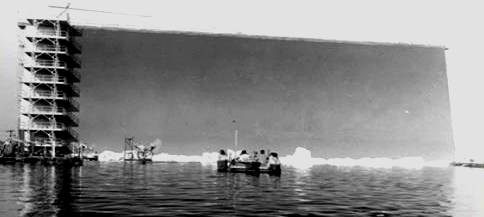After the recap ,
American Cinematographer contributor Herb Lightman dives into
the technical aspects of the film, noting that effects are
highlighted right out of the gate after the opening credits
with Seaview's famous "emergency
blow" surfacing
sequence    |
|
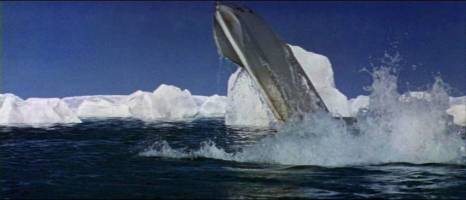 |
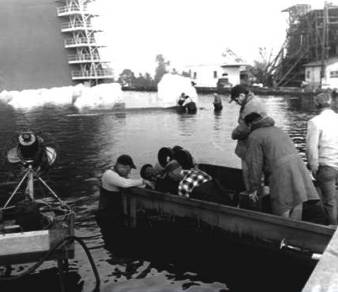 Technicians prepare barge mounted camera
for filming of
Technicians prepare barge mounted camera
for filming of
Seaview (mid-upper center, "ice bergs" behind her.)
|
|
   The
initial dramatic scene was shot on Fox's Sersen
Lake, as were all "surface" effects
shots. The
polar sea is seen to boil up as our favorite futuristic sub
leaps out of the water and comes to rest on the surface. To
produce the action, 20th Century Fox's Special Effects Department,
under the supervision of veteran effects expert L.B.
(Bill) Abbott, ASC, constructed an approximately 17',
3" model of Seaview, one of three
different scale miniatures built for the shooting. (*Note
--the article incorrectly refers to the model's length
as 20 feet.) The
model was positioned below water
in a pit created in 1953 for the shooting of Fox's 1954
release, Titanic. By
means of a trip release and a winch with a line attached
to the sub, the craft's natural buoyancy was accelerated
for the "jump-up" effect. The
initial dramatic scene was shot on Fox's Sersen
Lake, as were all "surface" effects
shots. The
polar sea is seen to boil up as our favorite futuristic sub
leaps out of the water and comes to rest on the surface. To
produce the action, 20th Century Fox's Special Effects Department,
under the supervision of veteran effects expert L.B.
(Bill) Abbott, ASC, constructed an approximately 17',
3" model of Seaview, one of three
different scale miniatures built for the shooting. (*Note
--the article incorrectly refers to the model's length
as 20 feet.) The
model was positioned below water
in a pit created in 1953 for the shooting of Fox's 1954
release, Titanic. By
means of a trip release and a winch with a line attached
to the sub, the craft's natural buoyancy was accelerated
for the "jump-up" effect. |
Within the sub
model itself, high-pressure water hoses connected to the
ballast vents produced the effect of water gushing forth
from the sub as it surfaced.   
The
addition of detergent added to the water created the desired
effect of foaming turbulence. The spectacular opening
shot duplicates a real "emergency blow" surface
maneuver which producer Irwin Allen was familiar with from
his research efforts. |
|
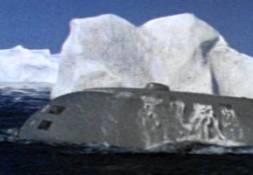 Foaming water gushes from ballast vents.
Foaming water gushes from ballast vents. |
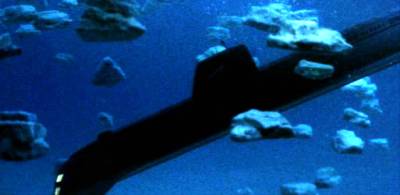 |
An effective scene early
in the film shows the submerged Seaview gliding through dark
waters beneath a "ceiling" of polar ice. The
bergs begin to disintegrate and huge chunks of ice crash down
on the stricken sub. The icebergs, Abbott explained, were
created out of individual metal frameworks covered with wire
mesh. Over these were placed several thicknesses of cheese cloth,
then the assemblies were |
| covered with wax.
A major problem was getting the various sized iceberg props (size,
4 to 24 inches) to descend at the right speed in order to look
realistic. Each
was individually weighted so as to have relative buoyancy; the
smaller bergs had to fall at the same rate as than the larger
ones. The icebergs were arranged on planks overhead above the
water's surface and dropped into the studio tank by technicians
as the camera rolled. The
divers had to retrieve the various iceberg miniatures and realign
them for the retakes and shots to follow. Note--underwater
shots were filmed in the studio "tank," as opposed
to the Sersen Lake, which for the most part was only several
feet deep and used exclusively for filming surface shots. |
|
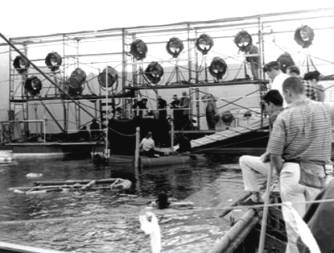
Studio
tank with rows of attendant lights and other gear. |
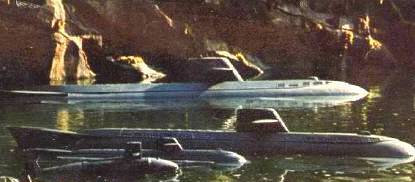
The movie's four principal models. the 17-plus, 8 and 4 foot
models and the
generic teardrop sub taken out of storage for the
1964 season of the TV show. |
|
In
addition to the 17-plus-foot model used for surface shots,
there was also an eight-foot model for underwater shots in
the Fox tank, and
an approximately four-foot model which was built to scale for
the octopus attack sequence. The octo attack scenes were
shot in a relatively small aquarium type tank as a technical
assistant manipulated the model by hand. |
| For the sequence in which the
mini-sub exits Seaview to head forward to the nose to free a
mine from the sub's searchlight casing, the large model, built
specifically for surface shots, was submerged in the tank in
a stationary position. |

| It was equipped with
an electrically controlled hatch from which a small eleven-inch
model of the mini-sub could be released, guided by fine wires,
which carefully lit, were invisible on screen. |
A larger
model of the mini-sub was built to a scale carefully calculated
with respect to the explosion which was to demolish it, so
that the explosion would appear as real as possible. The
result was viscerally effective, as the larger scale mini-sub
model was actually blown up, the explosive charges planted
within, and the resulting footage processed against a matte
of Seaview's observation nose ports.
Mouse-over at right for dramatic result.    |
|
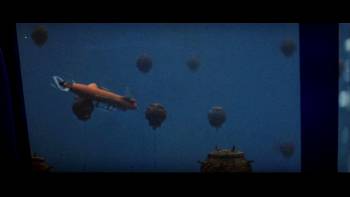 |
| In a special effect
project such as this, Abbott explained, the studio's miniature
prop shop contributes substantially. Herb
Cheek, head of the shop and considered one of the top experts
in the business, supervised the construction of the various
models required. |
| Virtually
all of the underwater scenes for Voyage were staged in the studio
tank, as pictured at (right)--60 feet square and 11 feet deep. The
special effects photography was done with the camera mounted
in an open-top
"diving bell" camera barge (see below) set into the tank. Pontoons
attached to the sides kept it afloat. The curvature of the convex
glass port served to nullify the refraction of the water, which, would
otherwise magnify underwater objects (Seaview included) about one-third,
thus making it necessary to work in a much larger underwater set to
achieve the same pictorial depth. |
|
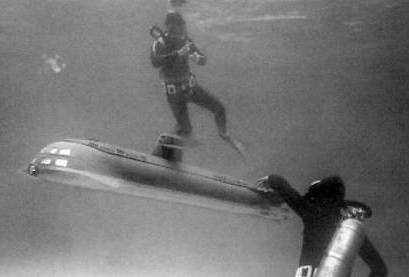 |
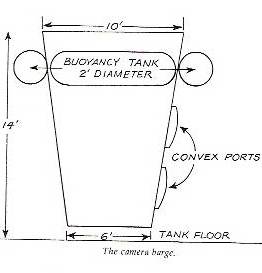
L.B.
Abbott drawing of camera barge above,
from his book on Special Effects. |
|
The curved
glass, cut down refraction and allowed normal
perspec-tive. An added advantage of
shooting through the curved glass using a 75m lens was that it
was possible to achieve a depth
of field ranging from 4 and 1/2 to 12 feet. In miniature
work, the depth of field factor is especially critical, particularly
when filming with CinemaScope lenses,
which characteristically lacked depth. |
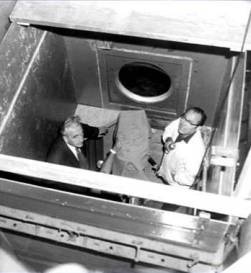
Photographer
Winton Hoch & Irwin Allen
gaze up from within the camera barge. |
End Part 1. Part 2 coming soon.
| "Voyage
to the Bottom of the Sea" ® is a registered trademark
of Irwin Allen Properties, LLC. © Irwin Allen Properties,
LLC and Twentieth Century Fox Film Corporation. All rights
reserved. |
|
